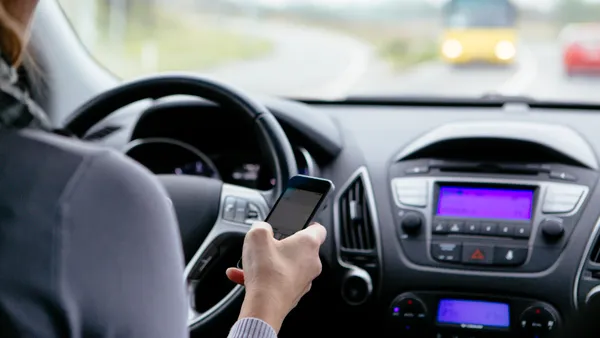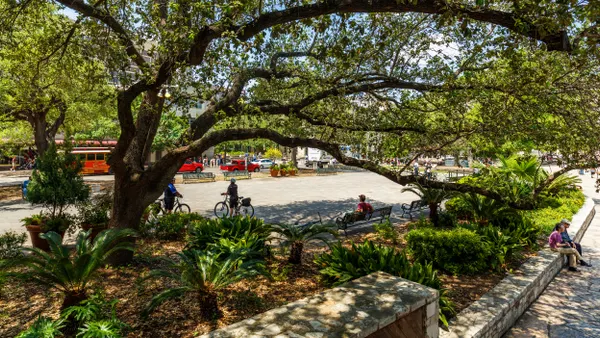In the few years since dockless bikes and scooters hit U.S. markets, cities have already seen their potential to cut vehicle emissions.
A November 2019 report from the City of Santa Monica, CA found that nearly 50% of shared mobility trips replaced car trips in one year, while a separate Bird-funded report found light electric vehicles (EVs) could account for 21% of all trips in Paris around 2030, up from about 1% today.
But plenty of work must be done to combat lingering doubts around scooters' long-term sustainability, given the devices' traditionally short life spans. A study from North Carolina State University found e-scooters still account for considerable emission levels due to manufacturing and maintenance needs, as well as the need to use cars and vans to re-balance the fleets on city streets.
Bird's Head of Sustainability Melinda Hanson believes 2020 could be a big year for dockless scooter companies to improve emissions-cutting efforts, while encouraging safer streets and infrastructure.
Smart Cities Dive caught up with Hanson to discuss the company’s efforts around sustainability, what cities can do to encourage further dockless use and how technological developments are helping micromobility become more environmentally friendly.
This interview has been edited for brevity and clarity
SMART CITIES DIVE: What trends did you notice last year in terms of sustainability in the dockless space?
MELINDA HANSON: The most important trend that I noticed — and that we verified with the research and surveying that we did internally, and that a lot of cities around the world found — is that electric scooters were succeeding in getting a lot of people onto two wheels for the first time. A lot of people who never considered riding bicycles, didn't participate in traditional dock-based bike-share schemes, were trying scooters.
Also, about one-third to one-half of all scooter trips in the majority of U.S. cities that we've surveyed are trips that are replacing car trips, and many of those are replacing Uber and Lyft trips, which as we've found out more recently, have a higher negative impact on sustainability for all the deadheading miles. The most exciting thing is that scooters prove to be a very compelling and attractive mode of sustainable transportation and show a lot of promise for replacing car trips.
What does that mean for the cities they're in?
HANSON: One of the things I hear from a lot of my network is that because e-scooters are so popular, they're really helping cities to implement the type of bicycle infrastructure that they've wanted to implement for a long time. And they're also helping cities to begin to close that first-mile, last-mile transit gap that's long been an insurmountable problem among sustainable transport wonks.
The scooter is of course only one potential mode, but just the fact that it's opened up a new world of not only getting new people to try to be on two wheels, just getting more converts, more people who are actually enthusiastic about trying to transport themselves without using a car ... All the partnerships that we're doing with cities to help provide the data shows them, for example, where they can strategically invest to provide bike lanes in places where people are riding.
Historically, a lot of the ways that some of these [bike lane] decisions were made were partially informed by interns at city planning departments standing there clicking how many bikes were going by in a certain hour, which is such an inefficient way of doing this. Now, through our partnerships with cities, we can say, "Hey look guys, this is a really, really popular corridor, and you don't have a bike lane there. Here's some data and figures, bring this to your city council meeting and let's get a bike lane built there so we can provide safer and more direct rides."
On the sustainability piece, a lot of emissions come from manufacturing, maintenance and rebalancing scooter fleets. What work are you doing to bring those numbers down?
HANSON: The industry started off with consumer model scooters which were not designed to be ridden as frequently and to be moved around as frequently and left out in the elements. The early models of Bird scooters at least were lasting three to four months. But now we're up to our third in-house model, the Bird Two.
We've learned a lot in the past two years, collected a lot of data about what parts tend to wear down, what features need to be reinforced to make sure that the scooter is durable. In our Bird Zero, which is the one that we've had on the ground since October 2018, the majority of our fleet is still on the road and our production suggests those will last 18 months. That's really, I think, the biggest sign of progress, and you can expect that pace of progress will continue as the design is more robust, as the overall maintenance is more systematized and as there's much more of a handle gotten on retention of the fleet.
In addition to that, which is of course closely aligned with the overall manufacturing emissions, we conducted a life-cycle assessment to understand what our emissions portfolio looks like. So we have initiatives really all throughout that life-cycle impact, starting with improving and increasing the lifespan of the vehicle, since that is really the biggest piece. The second piece is reducing the vehicle miles traveled associated with redistribution and with charging.
One of the most exciting things that has happened on that front is improvements in our battery. The Bird One and Bird Two are fully custom-designed, including the battery, so a lot of improvements have been made to better enclose the battery and have a more sophisticated battery management system, which is not only extending the overall lifetime of the battery but also allowing the scooters to hold their charge longer over time so that they're traveling 20 to 30 miles on a single charge. Just that ability of a scooter to be out there and available to riders for several days before it needs to get charged is going to go a long way to reducing the vehicle miles traveled.
What policies do you want to see at the city level to encourage further use of scooters and to make them a viable part of combating emissions?
HANSON: The correlation between road safety and advancing any kind of sustainable mode of transportation is increasingly being understood. If cities want to usher in this era of sustainable mobility, which a lot of it comes down to electrification and right-sizing of the vehicles, they need to have safer streets. And they need to get those soon.
In addition to that realization, we're seeing a lot more cities reclaim street space completely from cars. For example New York City reclaimed 14th Street: no private cars are allowed, they gave it all over to transit and pedestrians and cyclists, which is incredibly compelling and is a quick action policy ... It reduces the amount of bureaucracy that each green lane needs to go through, so that we're more rapidly building the kind of infrastructure that is absolutely crucial to supporting the mode shift that we want to see both in micromobility and in transit.
What are the most exciting trends in sustainability you're looking forward to this year for micromobility?
HANSON: The electric scooter phenomenon has shown how much demand there is for other options. In the same way it's been a lot of people's first time on two wheels, it's really a gateway to get people to try new types of vehicles. Everything's happening together in terms of improvements in different vehicle design, extension and expansion of the type of vehicles offered, improvements in battery technologies that are enabling these different types of lightweight vehicles.
I think the electric scooter is really just the beginning ... All these auto manufacturers are really getting into lightweight vehicles and promoting the lightweight electric vehicle or electric bicycle. The scooter started it, but you could expect to see way more vehicles coming on the scene.











